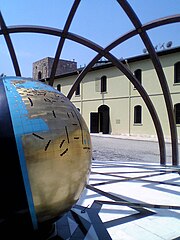What Happened to the Ancient Library of Alexandria?
Labels: History of Science, Libraries
Labels: History of Science, Libraries
Labels: History of Science, New Media
 The Islamic Science and Technology Museum gets a mention in "Fathers of Invention: What the Muslims Gave the Scientific World" by Jennifer Hattam (Wired magazine, of June 2009). The museum celebrates scientific and technological discoveries from Islamic scholars and makes the point Islam is not anti-science. Examples from the ancient world include the Alembic, for the distillation of liquids and the Astrolabe, a mechanical calculator for navigation. I was fortunate enough to visit the museum in Istanbul shortly after it opened, in May 2008. It is well worth a visit.
The Islamic Science and Technology Museum gets a mention in "Fathers of Invention: What the Muslims Gave the Scientific World" by Jennifer Hattam (Wired magazine, of June 2009). The museum celebrates scientific and technological discoveries from Islamic scholars and makes the point Islam is not anti-science. Examples from the ancient world include the Alembic, for the distillation of liquids and the Astrolabe, a mechanical calculator for navigation. I was fortunate enough to visit the museum in Istanbul shortly after it opened, in May 2008. It is well worth a visit.Labels: History of Science, Islam, Istanbul, wired magazine
Labels: historic house, History of Science, Internet Radio, Sydney
At the ACS Victorian Branch 2009 Conference someone mentioned there was an Historical Tour of Computing in Melbourne. Unfortunately I missed the tour as I was at the conference. The next one is Sunday 31 May 2009. The tours are run by Caulfield School of Information Technology (Monash University) and are free, apart from your tram ticket. Many of the sites on the tour are accessible without the tour and the tour guide web page provides a useful self-guide. The highlight of any such tour has to be CSIRAC at the Melbourne Museum, the fourth computer in the world and the best preserved.
The Tour:
Labels: ACS, CSIRAC, History of Science, ICT History, Melbourne
 Science and Islam: A History by Ehsan Masood (Icon Books Ltd , 2009) gets a good review in New Scientist ("Time to acknowledge science's debt to Islam?, Jo Marchant 25 February 2009). Both the book and the reviewer look for explanations for science not being as prominent in the Islamic world. However, I doubt this is a real phenomenon and may be just bad marketing on the part of science. As an example I visited the Museum of Technology and Islam the day after it opened in Istanbul. By now I assumed I would easily find details of the museum and its fascinating exhibits on the web. But the museum seems to be hard to find and Masood's book has no mention of the Museum.
Science and Islam: A History by Ehsan Masood (Icon Books Ltd , 2009) gets a good review in New Scientist ("Time to acknowledge science's debt to Islam?, Jo Marchant 25 February 2009). Both the book and the reviewer look for explanations for science not being as prominent in the Islamic world. However, I doubt this is a real phenomenon and may be just bad marketing on the part of science. As an example I visited the Museum of Technology and Islam the day after it opened in Istanbul. By now I assumed I would easily find details of the museum and its fascinating exhibits on the web. But the museum seems to be hard to find and Masood's book has no mention of the Museum.Labels: Culture, History of Science, Islam, Istanbul, Scholarly Publishing, Turkey
Labels: History of Science, Istanbul, Turkey
 Walking through Gülhane Park in İstanbul today, I noticed a sign announcing the opening of the "Istanbul Museum of the History of Science and Technology in Islam". I stuck my head in the door and met Dr. Detlev Quintern from Bremen University. The Islamic Science and Technology Historical Museum was opened Saturday by the Turkish Prime Minister Recep Tayyip Erdogan.
Walking through Gülhane Park in İstanbul today, I noticed a sign announcing the opening of the "Istanbul Museum of the History of Science and Technology in Islam". I stuck my head in the door and met Dr. Detlev Quintern from Bremen University. The Islamic Science and Technology Historical Museum was opened Saturday by the Turkish Prime Minister Recep Tayyip Erdogan.Labels: Culture, History of Science, Scholarly Publishing, Turkey